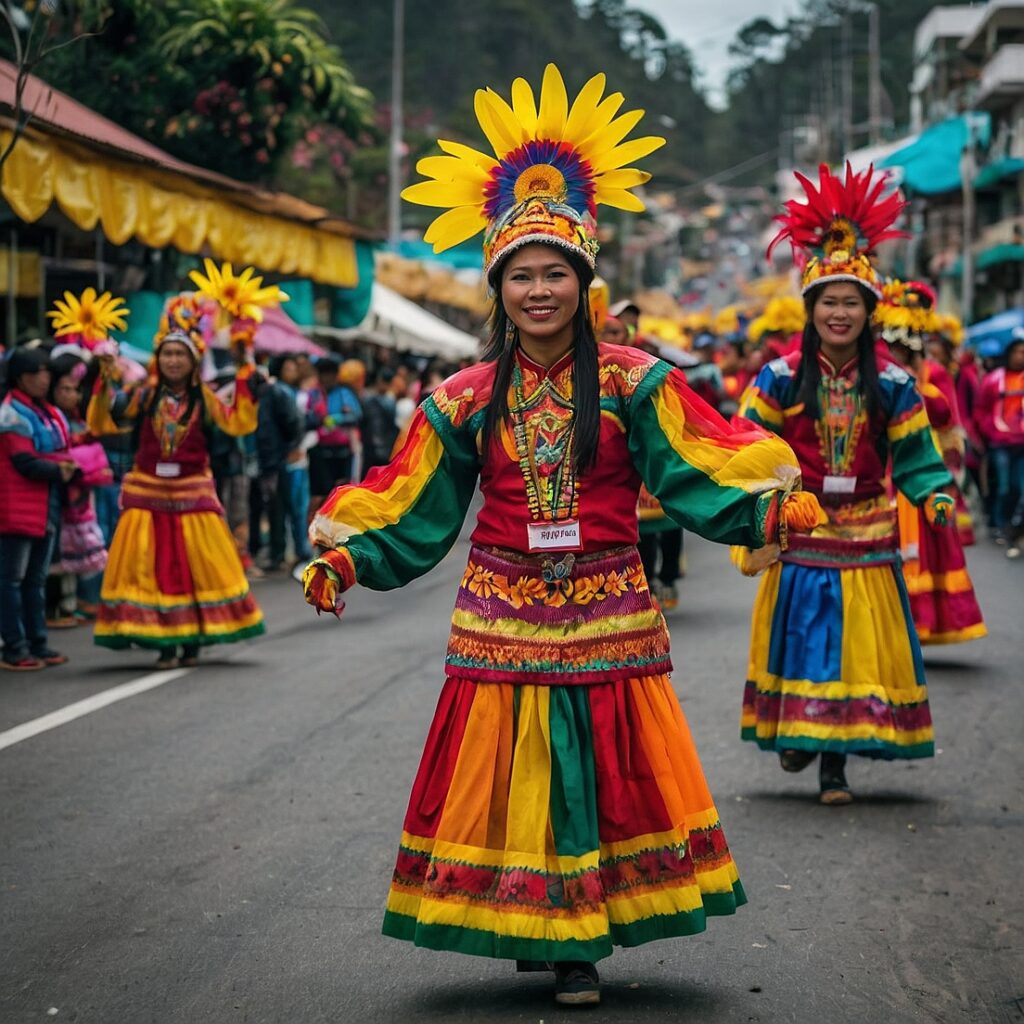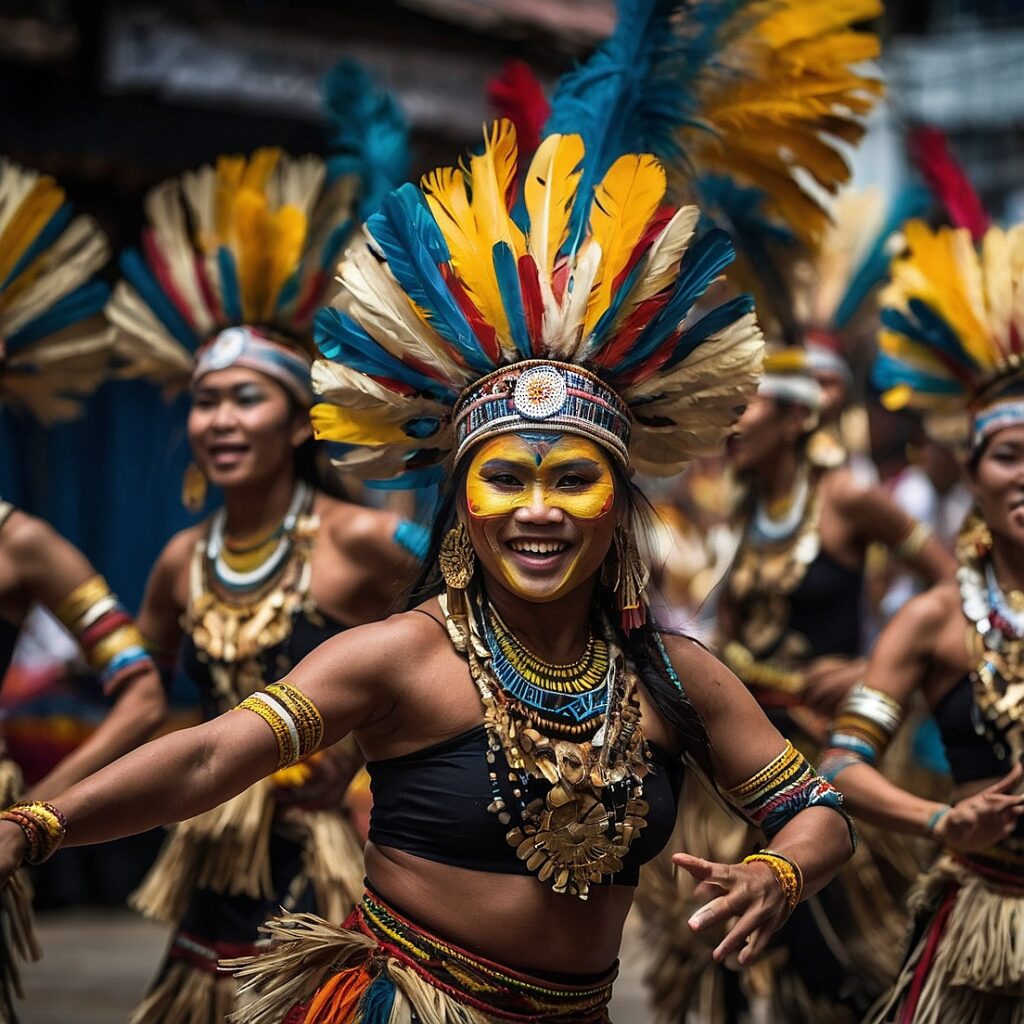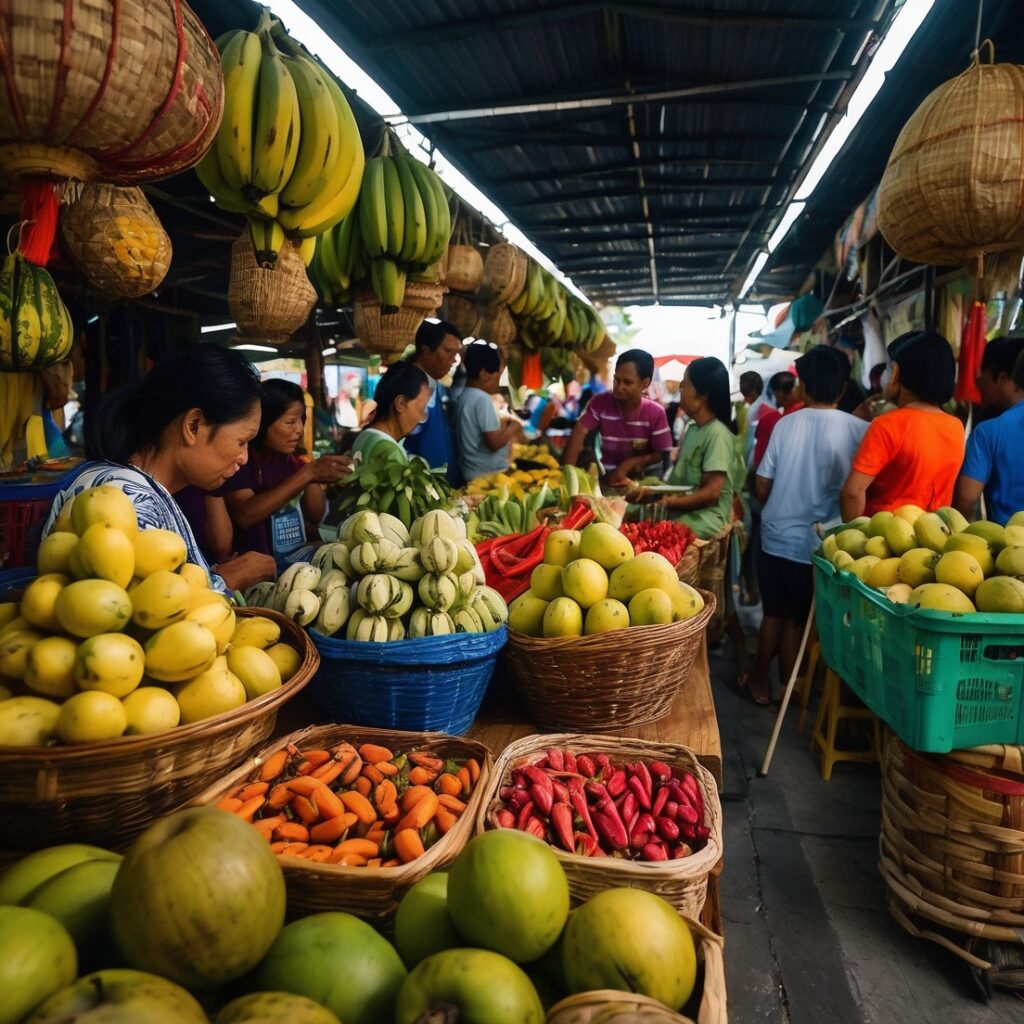Welcome, flower enthusiasts and culture lovers! Today, we’re diving into the vibrant world of the Panagbenga Festival, a dazzling celebration that transforms Baguio City into a kaleidoscope of colors every February. Picture this: streets lined with intricate floral floats, dancers adorned in petal-inspired costumes, and the sweet scent of blooms filling the air. It’s a feast for the senses that draws visitors from all corners of the globe. But Panagbenga is more than just a pretty face – it’s a testament to Baguio’s rich heritage, a boost to the local economy, and a symbol of hope and rebirth. So, grab a cup of coffee (or better yet, some Benguet brew), and let’s explore the wonders of this floral extravaganza!
The Roots of Panagbenga: A Blossoming Tradition
A Festival is Born
Let’s take a little trip back in time, shall we? The year was 1995, and Baguio City was still recovering from the devastating earthquake that had struck in 1990. The city needed something to lift its spirits, to remind its people of the beauty and resilience that surrounded them. Enter lawyer Damaso Bangaoet Jr., who planted the seed of an idea that would grow into the Panagbenga Festival we know and love today.
The name “Panagbenga” comes from the Kankanaey term meaning “season of blooming,” and oh boy, does this festival live up to its name! It was designed to celebrate the flowers that thrive in Baguio’s cool climate and to pay homage to the city’s rich cultural heritage. The first festival was held in 1996, and it’s been blossoming ever since.
From Seedling to Full Bloom
What started as a week-long celebration has now grown into a month-long spectacle that draws hundreds of thousands of visitors each year. The festival has evolved to include parades, exhibitions, concerts, and even a beauty pageant. But at its core, Panagbenga remains true to its original purpose: to showcase the natural beauty of Baguio and the warmth of its people.
Here’s a quick look at how the festival has grown over the years:
| Year | Estimated Visitors | Notable Additions |
|---|---|---|
| 1996 | 50,000 | Inaugural festival |
| 2000 | 500,000 | Introduction of the Grand Float Parade |
| 2010 | 1,000,000 | Addition of the Session Road in Bloom event |
| 2020 | 1,500,000 | Last festival before the pandemic hiatus |
As you can see, this little seedling of an idea has blossomed into quite the spectacle!
The Main Events: A Petal-by-Petal Guide
Grand Street Dancing Parade: A Moving Garden
Imagine thousands of dancers, decked out in costumes inspired by flowers and indigenous patterns, swirling through the streets of Baguio. That’s the Grand Street Dancing Parade for you! It’s a riot of color, music, and movement that kicks off the festival’s main weekend. Local schools, community groups, and even professional dance troupes compete to create the most dazzling performances. The choreography often tells stories of Cordilleran culture and traditions, blending the old with the new in a mesmerizing display.
Grand Float Parade: Blooms on Wheels
If the Street Dancing Parade is the appetizer, the Grand Float Parade is definitely the main course of Panagbenga. Picture massive floats, each one a masterpiece of floral artistry, slowly making their way down Session Road. These aren’t just any floats – we’re talking about intricate designs made entirely of fresh flowers and plants native to the Cordillera region. From giant butterflies to replicas of famous landmarks, the creativity on display is truly mind-blowing. Companies, government agencies, and local organizations all compete to create the most awe-inspiring float. It’s like a moving art gallery, and trust me, your camera will be working overtime!
Session Road in Bloom: A Floral Market Extravaganza
After the parades have passed, the party isn’t over – it’s just moving to Session Road! For a whole week, this main thoroughfare is closed to traffic and transformed into a vibrant marketplace and exhibition space. Stalls line the street, selling everything from fresh flowers and plants to local crafts and delicacies. It’s the perfect place to pick up some souvenirs, sample Baguio’s famous strawberries, or just soak in the festive atmosphere. Street performances, art installations, and food festivals add to the lively vibe. It’s like the whole city becomes one big garden party!
Beyond the Blooms: Cultural Significance and Impact
Celebrating Cordilleran Heritage
While the flowers are undoubtedly the stars of the show, Panagbenga is about so much more than just pretty petals. It’s a celebration of the rich cultural heritage of the Cordillera region. Throughout the festival, you’ll see elements of indigenous culture woven into every aspect – from the intricate patterns on dancers’ costumes to the traditional music accompanying the parades.
The festival provides a platform for local artists, musicians, and craftspeople to showcase their talents and keep ancient traditions alive. It’s not uncommon to see demonstrations of traditional weaving techniques, wood carving, or even indigenous martial arts during the month-long celebration. Panagbenga serves as a vibrant reminder of the unique identity of the Cordillera people and helps to preserve and promote their culture for future generations.
Economic Bloom: The Festival’s Impact on Baguio
Let’s talk numbers for a moment, shall we? The Panagbenga Festival isn’t just a feast for the eyes – it’s also a major economic driver for Baguio City and the surrounding region. The influx of visitors during the festival season provides a significant boost to local businesses, from hotels and restaurants to small handicraft vendors.
Here’s a quick breakdown of the economic impact in recent years:
| Year | Estimated Economic Impact | Number of Visitors |
|---|---|---|
| 2018 | ₱2.3 billion | 1.5 million |
| 2019 | ₱2.5 billion | 1.6 million |
| 2020 | ₱2.7 billion | 1.5 million |
These figures represent a substantial injection into the local economy, creating jobs and supporting livelihoods across various sectors. The festival has become so important that many businesses in Baguio plan their entire year around this month-long event!
Environmental Awareness: Blooming Responsibly
Now, you might be wondering – with all these flowers and all these people, what about the environmental impact? Well, the organizers of Panagbenga have thought of that too. In recent years, there’s been a growing emphasis on environmental sustainability within the festival.
Efforts have been made to reduce waste, promote recycling, and use more eco-friendly materials in float construction. Many of the flowers used in the displays are locally grown, reducing transportation emissions and supporting local agriculture. There are also educational components to the festival that focus on environmental conservation and the importance of preserving Baguio’s natural beauty.
It’s a delicate balance, but Panagbenga strives to celebrate nature while also protecting it. After all, without the lush environment of the Cordilleras, there would be no flowers to celebrate!
The Panagbenga Experience: Tips for Visitors
When to Go: Timing Your Visit
If you’re planning to experience Panagbenga firsthand (and trust me, you should!), timing is everything. The festival typically runs for the entire month of February, with the main events happening on the last weekend of the month. However, it’s worth noting that the exact dates can vary slightly from year to year, so it’s always a good idea to check the official schedule before booking your trip.
Here’s a general timeline to help you plan:
- Opening Parade: First Sunday of February
- Month-long events: Throughout February
- Grand Street Dancing Parade: Last Saturday of February
- Grand Float Parade: Last Sunday of February
- Session Road in Bloom: Week following the Grand Parades
Remember, Baguio gets pretty crowded during Panagbenga, so book your accommodations well in advance!
What to Wear: Dressing for the Festival
Baguio is known as the “Summer Capital of the Philippines” due to its cooler climate, so don’t forget to pack some layers! February temperatures can range from about 15°C to 23°C (59°F to 73°F). During the day, it can be quite warm, especially when you’re in the midst of the festival crowds. But once the sun sets, you’ll definitely feel the chill.
Here are some packing suggestions:
- Light, breathable clothing for daytime events
- A light jacket or sweater for evenings
- Comfortable walking shoes (you’ll be doing a lot of it!)
- A hat and sunglasses to protect you from the sun
- A small backpack for carrying water and essentials
And don’t forget to bring your camera – you’ll want to capture every colorful moment!
Getting Around: Navigating the Flower-Filled Streets
During Panagbenga, Baguio becomes a sea of people, and many streets are closed to traffic for events. While this can make getting around a bit challenging, it’s also part of the fun! Here are some tips for navigating the festival:
- Walk if you can: Many of the main events are within walking distance of each other, and strolling allows you to soak in the festive atmosphere.
- Use public transportation: Jeepneys and taxis are still available, but expect them to be crowded and to follow alternative routes.
- Book a hotel near Session Road: This puts you right in the heart of the action.
- Be patient: Remember, everyone’s there to have a good time. Embrace the crowds as part of the experience!
- Get an early start: Especially for the parades, arriving early helps you secure a good viewing spot.
Beyond the Festival: Exploring Baguio City
Natural Wonders: Baguio’s Green Spaces
While Panagbenga brings its own explosion of color to Baguio, the city is a nature lover’s paradise year-round. Once you’ve had your fill of the festival activities, why not explore some of Baguio’s famous parks and gardens? Here are a few must-visit spots:
- Burnham Park: This central park is the green heart of Baguio. Rent a boat on the lake, enjoy a picnic, or just people-watch.
- Camp John Hay: Once a US military base, now a forest reserve with hiking trails, a golf course, and plenty of pine trees.
- Botanical Garden: Showcases the diverse flora of the Cordilleras. It’s like Panagbenga in miniature!
- Wright Park: Known for its long pool lined with pine trees. You can even go horseback riding here.
These green spaces offer a peaceful retreat from the festival hustle and bustle, and they’re beautiful any time of year.
Cultural Attractions: Diving Deeper into Cordilleran Heritage
If Panagbenga has piqued your interest in Cordilleran culture, you’re in luck! Baguio offers several attractions where you can learn more about the region’s rich heritage:
- BenCab Museum: Features works by national artist Benedicto Cabrera, including a section dedicated to Cordilleran art and artifacts.
- Tam-awan Village: A living museum that recreates a traditional Cordilleran village, complete with native huts and art galleries.
- Ifugao Woodcarvers’ Village: Watch skilled artisans create intricate wooden sculptures and pick up unique souvenirs.
These attractions offer a deeper dive into the culture that Panagbenga celebrates, helping you appreciate the festival on a whole new level.
Culinary Delights: Tasting Baguio
All that flower-gazing is bound to work up an appetite! Baguio’s cool climate allows it to grow a variety of produce not found in lowland areas, leading to a unique local cuisine. Here are some must-try local delicacies:
- Strawberries: Baguio is famous for its strawberries. Try them fresh, in jam, or in the popular strawberry taho (a sweet tofu dessert).
- Ube Jam: This purple yam jam is a favorite pasalubong (souvenir) from Baguio.
- Longganisa: Baguio’s version of this Filipino sausage has a distinct garlicky flavor.
- Sagada Orange Marmalade: Made from oranges grown in nearby Sagada.
- Benguet Coffee: Locally grown and full of flavor. Perfect for Baguio’s chilly mornings!
Don’t forget to visit the public market to sample these treats and more. It’s a feast for all your senses!
The Future of Panagbenga: Blossoming in Changing Times
Adapting to Challenges: The Festival’s Resilience
Like many events worldwide, Panagbenga faced unprecedented challenges in 2020 and 2021 due to the global pandemic. The festival was cancelled for the first time in its history in 2020, and again in 2021. However, the spirit of Panagbenga proved as resilient as the flowers it celebrates. Virtual events were organized, allowing people to experience the festival’s beauty and cultural significance from the safety of their homes.
As we look to the future, there’s no doubt that Panagbenga will continue to adapt and evolve. The festival has always been about renewal and rebirth, and these themes seem more relevant than ever. When it returns in full force, Panagbenga will likely incorporate lessons learned during its hiatus, perhaps blending virtual and physical elements to create an even more inclusive and far-reaching celebration.
Growing Sustainably: The Green Future of Panagbenga
As awareness of environmental issues grows globally, Panagbenga is poised to lead the way in sustainable festival practices. Future editions of the festival may see increased use of recycled materials in float construction, more emphasis on locally-sourced flowers, and innovative waste reduction strategies.
There’s also potential for the festival to become a platform for environmental education, using its popularity to raise awareness about conservation issues affecting the Cordillera region. Imagine floats that not only showcase beautiful flowers but also tell stories about endangered species or the importance of forest preservation. Panagbenga could bloom into a powerful force for positive change!
The Lasting Impact of Panagbenga
As our journey through the Panagbenga Festival comes to an end, it’s clear that this is so much more than just a flower festival. It’s a celebration of culture, a boost to the local economy, a showcase of creativity, and a reminder of the natural beauty that surrounds us. From its humble beginnings as a way to lift Baguio’s spirits after a natural disaster, Panagbenga has grown into an internationally recognized event that captures hearts and imaginations.
Whether you’re a nature lover, a culture enthusiast, a foodie, or just someone who enjoys a good party, Panagbenga has something for you. It’s a testament to the power of community, the beauty of tradition, and the joy of celebration. As the festival continues to evolve and grow, one thing remains constant: the spirit of Panagbenga, like the flowers it celebrates, will continue to bloom year after year, bringing color, joy, and unity to Baguio City and beyond.
So, why not start planning your trip to the next Panagbenga Festival? Come and see for yourself why this celebration has captured the hearts of so many. Who knows? You might just find yourself blooming with joy in the Summer Capital of the Philippines!
Disclaimer: This blog post is based on information available up to 2021. While we strive for accuracy, details about the Panagbenga Festival may have changed since then. Please check official sources for the most up-to-date information when planning your visit. If you notice any inaccuracies, please report them so we can correct them promptly.




